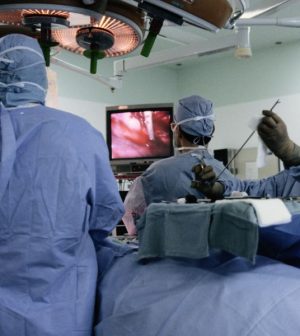- Navigating Your Midlife Crisis: Embracing New Possibilities
- City Raccoons Showing Signs of Domestication
- Mapping the Exposome: Science Broadens Focus to Environmental Disease Triggers
- One Week Less on Social Media Linked to Better Mental Health
- Your Brain Changes in Stages as You Age, Study Finds
- Some Suicide Victims Show No Typical Warning Signs, Study Finds
- ByHeart Formula Faces Lawsuits After Babies Sickened With Botulism
- Switch to Vegan Diet Could Cut Your Greenhouse Gas Emissions in Half
- Regular Bedtime Does Wonders for Blood Pressure
- Dining Alone Could Mean Worse Nutrition for Seniors
Awake for Aneurysm Brain Surgery, Better Results?

“Awake” brain surgery may improve treatment of brain aneurysms, researchers say.
A brain aneurysm is a weak area in a blood vessel that supplies blood to the brain. It’s commonly treated with a surgical technique known as “clipping” while the patient is under general anesthesia.
But a team of researchers at Saint Louis University in Missouri found that “awake brain surgery,” using what’s called conscious sedation, might improve results.
Testing the procedure on 30 aneurysm patients, study leader Dr. Saleem Abdulrauf and his team were able to communicate with the patients and test their brain function during surgery.
During the operation, surgeons open the skull and clip the artery below the aneurysm so blood can no longer enter it. This causes the blood vessel to shrink and prevents it from rupturing. A ruptured aneurysm can lead to serious disability or death, according to the U.S. National Institute of Neurological Disorders and Stroke.
While sedated but conscious, three of the 30 patients developed warning signs of blocked blood flow, such as blurred vision or the inability to make a fist.
When these warning signs developed, the doctors were able to reposition the clips and resolve potential issues within seconds, said Abdulrauf, chair of neurosurgery at the university.
“It happens instantly. It’s amazing,” he said.
The patients never felt pain, Abdulrauf said. They were deeply asleep as the surgical team removed a piece of their skull and exposed the affected part of their brain. The patients were only awake and alert while their aneurysm was being clipped and the brain itself has no pain receptors, he explained.
With standard surgery under general anesthesia, when one or more clips are placed there may be tiny vessels behind the aneurysm that could inadvertently get closed off, Abdulrauf said.
If these blocked arteries supply brain regions involved in critical function, such as speech, movement and vision, patients could wake up with permanent neurological deficits, he added.
Abdulrauf explained that brain wave monitoring that’s done while patients are under general anesthesia isn’t totally reliable. There is also no way to monitor patients’ vision when they are asleep, he said.
Awake surgery may have other advantages, too. It eliminates some of the risks associated with general anesthesia and provides a viable option for patients with life-threatening brain aneurysms who are not candidates for general anesthesia, the researchers said.
This type of surgery is already used to treat seizures and some brain tumors.
However, awake brain surgery isn’t for everyone.
“It takes a special patient,” said Dr. Mark Bain, a neurosurgeon at the Cleveland Clinic who wasn’t involved in the study.
Also, larger studies are still needed to investigate the benefits of conscious sedation during aneurysm clipping, he said.
There are a couple of important reasons for this, said Bain. “When patients are under general anesthesia, they are being mechanically ventilated and their brain is more relaxed,” he explained. Awake sedated patients may not breathe as well, causing the brain to swell. This can make it more difficult for surgeons to reach the aneurysm, he added.
Bain said brain aneurysm surgery is a very meticulous procedure involving tiny blood vessels. The possibility that a patient could move is a very big downside.
Meanwhile, there are effective nonsurgical treatments for brain aneurysms, such as coils and catheters, Bain pointed out. “We can get some type of protection with these less-invasive procedures,” he said.
Most brain aneurysms do not cause symptoms until they either become very large or burst. Overall, about 30,000 people in the United States suffer a ruptured brain aneurysm each year. Of these cases, about 40 percent are fatal within the first 24 hours and another 25 percent of patients die of complications within six months, according to the Institute of Neurological Disorders and Stroke.
The study findings were published in the August edition of the Journal of Neurosurgery.
More information
The U.S. National Institute for Neurological Disorders and Stroke has more on brain aneurysms.
Source: HealthDay
Copyright © 2025 HealthDay. All rights reserved.










